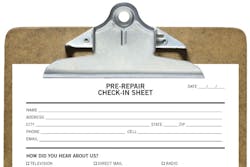Customer check-in sheets are an important part of the pre-repair process. But having a check-in sheet that customers will actually fill out is not always that simple. Dino DiGiulio, owner of Body Best Collision Center in Sonoma, Calif., says that his shop’s check-in sheet is vital to numerous areas of the business: customer communication, workflow and marketing. And there are a few keys to getting the sheet right: keeping it to one page, only including necessary information, and considering the needs of your shop.
DiGiulio outlines how he created a check-in sheet for his shop.
At the top is all of the customer contact information. That’s the most important piece for us. That information includes a mailing address, cell phone number, and email address. We send out an email newsletter and we’re gearing up to do direct email marketing, so gathering an accurate email list is very important to us.
The second most important part is asking how the customer heard about us. Many shops do not ask these types of questions. You spend quite a bit on marketing, so you want to be sure you’re spending it in the right places. First, we ask “How did you hear about us?” Then we also ask about specific mediums, like TV, direct mail or radio. On first glance, people often say they just happened to be driving by, but usually it’s something else they saw or heard that triggered them to come in.
We also ask if someone referred them to us, and if so, the name of the referring person. We will then send a thank-you card and small gift to that person.
We also have two small boxes: One for vehicle information (VIN number, license plate, mileage) and one for insurance information (insurance company, claim number and deductible). However, we have found that many people don’t know this information, so we will sometimes fill this part out for them.
Next is a section for writing a basic initial estimate. We’ll walk around the car with the customer and note the damage in one of three boxes on the sheet: Remove and replace, remove and install, and repair. There is a column next to each box where we can fill in the corresponding part. For example, we’ll check “remove and replace” and write “front bumper.” It’s a quick sheet to take notes on what you’re doing with the car and establishing that you’re on the same page with the customer.
To that end, we also have a section for customer concerns. For example, if they ask to touch up the rear bumper because it has a scratch in it, we will make a note of that.
You can get samples of check-in sheets from various sources, including consultants and your paint company (or you can download the one featured in this article). It’s a good way to have a starting point and make tweaks from there. You want to make sure it has a good flow, so don’t be afraid to move things around or make changes as it best relates to your shop.




